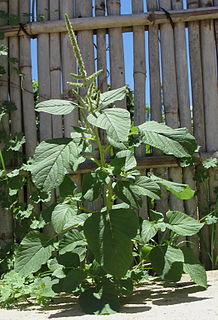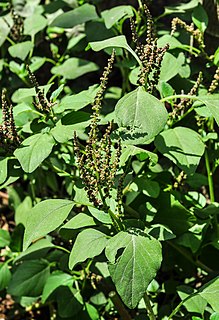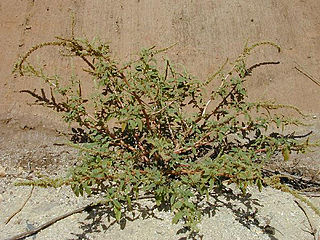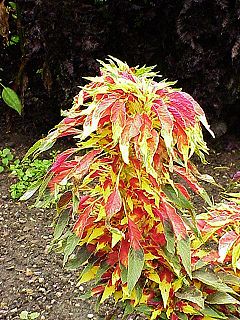
Amaranthus, collectively known as amaranth, is a cosmopolitan genus of annual or short-lived perennial plants. Some amaranth species are cultivated as leaf vegetables, pseudocereals, and ornamental plants. Most of the Amaranthus species are summer annual weeds and are commonly referred to as pigweed. Catkin-like cymes of densely packed flowers grow in summer or autumn. Approximately 60 species are recognized, with inflorescences and foliage ranging from purple, through red and green to gold. Members of this genus share many characteristics and uses with members of the closely related genus Celosia.
Pigweed can mean any of a number of weedy plants which may be used as pig fodder:

Callaloo is a popular Caribbean dish originating in West Africa served in different variants across the Caribbean. The main ingredient is a leaf vegetable, traditionally either amaranth, taro or Xanthosoma. Because the leaf vegetable used in some regions may be locally called "callaloo" or "callaloo bush" "Dasheen Leaves", some confusion can arise among the vegetables and with the dish itself. In Haiti, for example, the creole word "kalalou" refers to okra, and not to a leafy green. Outside of the Caribbean, water spinach is occasionally used. Trinidadians, Grenadians and Dominicans primarily use taro/dasheen bush for callaloo, although Dominicans also use water spinach. Jamaicans, Belizeans and Guyanese on the other hand use the name callaloo to refer to amaranth, and use it in a plethora of dishes and also a drink. The 'callaloo' made in Jamaica is different from the 'callaloo' made in Trinidad and Tobago Grenada and rest of the Caribbean in terms of main ingredient and other ingredients included. "callaloo" in Trinidad is used in a variety of dishes including Callaloo soup or "oil down" Trinidads specialities. Callaloo is the National Dish of the twin Island Republic of Trinidad and the Commonwealth of Dominica.
Quelite can mean any of a number of different plants commonly eaten in Mexico for their leaves, as leaf vegetables or herbs, including:

Amaranthus blitum, commonly called purple amaranth or Guernsey pigweed, is an annual plant species in economically important plant family Amaranthaceae.

Amaranthus viridis is a cosmopolitan species in the botanical family Amaranthaceae and is commonly known as slender amaranth or green amaranth.

Amaranthus hybridus, commonly called green amaranth, slim amaranth, smooth amaranth, smooth pigweed, or red amaranth, is a species of annual flowering plant. It is a weedy species found now over much of North America and introduced into Europe and Eurasia.

Amaranthus caudatus is a species of annual flowering plant. It goes by common names such as love-lies-bleeding, pendant amaranth, tassel flower, velvet flower, foxtail amaranth, and quilete.

Amaranthus hypochondriacus is an ornamental plant commonly known as Prince-of-Wales feather or prince's-feather. Originally endemic to Mexico, it is called quelite, blero and quintonil in Spanish.

Amaranthus spinosus, commonly known as the spiny amaranth, spiny pigweed, prickly amaranth or thorny amaranth, is a plant is native to the tropical Americas, but is present on most continents as an introduced species and sometimes a noxious weed. It can be a serious weed of rice cultivation in Asia.

Amaranthus retroflexus is a species of flowering plant in the Amaranthaceae family with several common names, including red-root amaranth, redroot pigweed, red-rooted pigweed, common amaranth, pigweed amaranth, and common tumbleweed.

Amaranthus tricolor, known as edible amaranth, is a species in the genus Amaranthus.

Amaranthus albus is an annual species of flowering plant. It is native to the tropical Americas but a widespread introduced species in other places, including Europe, Africa, and Australia.

Amaranthus dubius, the red spinach, Chinese spinach,, spleen amaranth, hon-toi-moi, yin choy, or hsien tsai is a plant species. It belongs to the economically important family Amaranthaceae.

Amaranthus cruentus is a flowering plant species that yields the nutritious staple amaranth grain. It is one of three Amaranthus species cultivated as a grain source, the other two being Amaranthus hypochondriacus and Amaranthus caudatus. In Mexico, it is called huautli (Spanish pronunciation: [ˈwautɬi] and alegría ([aleˈɣɾi.a] and in English it has several common names, including blood amaranth, red amaranth, purple amaranth, prince's feather, and Mexican grain amaranth. In Maharashtra, it is called shravani maath or rajgira.

Species belonging to the genus Amaranthus have been cultivated for their grains for 8,000 years. Amaranth plants are classified as pseudocereals that are grown for their edible starchy seeds, but they are not in the same botanical family as true cereals such as wheat and rice. Amaranth species that are still used as a grain are Amaranthus caudatus L., Amaranthus cruentus L., and Amaranthus hypochondriacus L. The yield of grain amaranth is comparable to rice or maize.

Amaranthus graecizans, the Mediterranean amaranth or short-tepalled pigweed, is an annual species in the botanical family Amaranthaceae. It is native to Africa, southern Europe, East Asia to India and Central Asia. It is naturalized in North America. More general common names include tumbleweed and pigweed.

Amaranthus is the third studio album by the Japanese girl group Momoiro Clover Z, released in Japan on February 17, 2016.

Hakkin no Yoake (白金の夜明け) is the fourth studio album by the Japanese girl group Momoiro Clover Z, released in Japan on February 17, 2016.
















